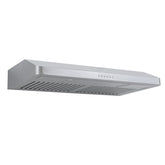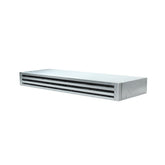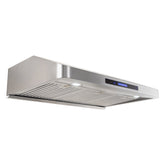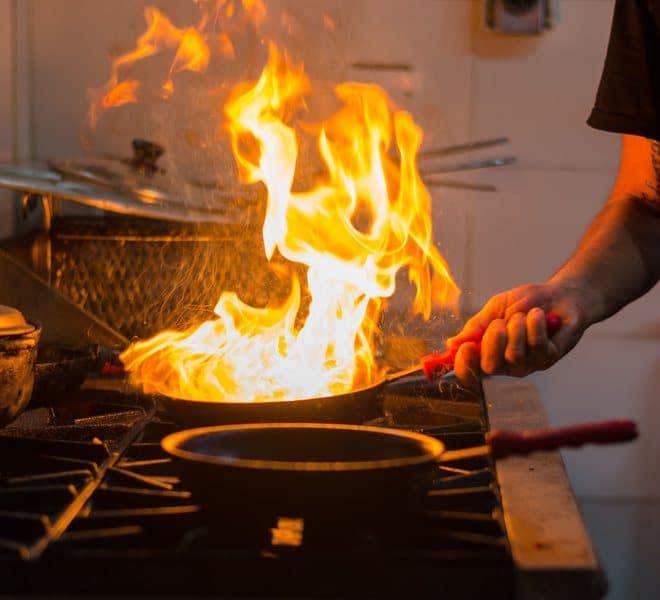Cooking fires are the leading cause of home fires and injuries.* More often than not, this involves frying. While you may not have to deal with a grease fire every day, it’s important to be prepared. We've all been there. A pot of oil is left on the stove and forgotten, burning away until it's too late.
Extinguishing a grease fire may seem like an impossible task, but don’t panic. A good hood vent will also help deal with the smoke.
This guide will show you how to put out a grease fire before it gets out of hand. Take a look at the YouTube video below for a quick easy way to put out a grease fire.
1. Cover the fire with a large lid.
The first step is to contain the fire as quickly as possible. The easiest way to do that is to use a large lid and place it over the fire. Grip the lid with a towel or hot pad to reduce the risk of burns, if possible.
A long flat pan like a baking sheet works great for this first step too.
Wait for the lid to cool entirely before removing it. You don’t want to get burned!
Important: Do not move the pan with flames outside. It’s risky! The pan will be incredibly hot and getting hotter every second. So if you try to take the pan outside, you may burn yourself. If you burn yourself, you could drop the pan and spread the fire throughout your home.
The goal is to first contain the fire. So, again, avoid the urge to bring the pan outside.
2. Turn off the burner(s).
It’s important to turn off the heat source once you’ve got the fire somewhat contained. Leaving the heat on can keep the fire going. It significantly increases the risk of the fire growing dangerously large.
3. For small fires, pour a generous amount of baking soda on the flames.
To begin extinguishing the fire, baking soda is your best bet. This won’t work as well for large fires but it can work incredibly well with smaller fires.
Important: Do not add water to the fire. Water will cause the cooking oil to splash and it may spread the fire to other areas of your kitchen. Also, the burning oil is incredibly hot, so you could burn yourself!
Important: Only use baking soda or salt to extinguish grease fires. It’s easy to confuse baking soda or salt with baking powder or flour.
4. If you still can’t contain the fire, use your fire extinguisher.
If baking soda isn’t enough and the fire is getting difficult to handle, use your fire extinguisher. Every kitchen has at least one, by law. It might be on the wall or in a cabinet. Next time you cook, make sure you locate yours in case of an emergency!
Tip: To reduce the risk of a grease fire, invest in a professional range hood. Check out our article ‘Do range hoods prevent grease fires?’ to learn more.
Can you use salt to put out a grease fire?
You can use salt to put out a grease fire. In fact, along with baking soda, it is one of the best chemicals to use to put out a grease fire. A fire needs oxygen to burn. Salt smothers it, preventing it from reaching the oxygen, which extinguishes the fire. For larger fires, you may have to use a lot of salt.
Can you use baking soda to put out a grease fire?
Yes, you can use baking soda to put out a grease fire. Like salt, it will take a lot of baking soda to put out a fire. So it’s best used to extinguish small fires.
Can you use vinegar to put out a grease fire?
Do not use vinegar to put out a grease fire. Like water, when you pour vinegar on a grease fire, it will splash oil everywhere which can be a fire hazard. Stick with dry ingredients like baking soda or salt, which deprive the fire of oxygen.
Can you use flour to put out a grease fire?
Do not use flour on a grease fire. Starch burns quickly and the small grains of flour will immediately combust! Instead, smother it with baking soda or salt.
Can you use milk to put out a grease fire?
Avoid pouring milk over a grease fire. The oil may splash which can cause serious burns and spread the fire! To contain it better, douse the fire with baking soda or salt. If that doesn’t work, use your fire extinguisher.
What Not to Use on A Grease Fire
Avoid using liquids on a grease fire. These may include water, vinegar, milk, or any other liquid you might be tempted to douse your fire with. Also, do not use flour or baking powder to extinguish a fire. Unlike baking soda, flour and baking powder are highly flammable.
Can cooking oil spontaneously combust?
Yes, but this is incredibly rare. Every oil has a smoke point, and most are around 400 - 450 degrees. But for oil to spontaneously ignite, it’d have to be almost twice as hot: around 700 to 800 degrees or more.
You can cause a grease fire to explode by adding flour, baking powder, or water to it. But by itself, oil needs to be incredibly hot to spontaneously ignite.
Why does water not work on a grease fire?
Instead of smothering or extinguishing a grease fire, water will splash the cooking oil around your kitchen. This can cause severe burns and spread the fire to other areas of the kitchen. Avoid using liquids on grease fires so you reduce the risk of spreading the flames.
Hopefully this guide helped you learn how to put out a grease fire. Remember, avoid dousing the flames with water and always be careful before touching a pan that’s next to the fire.
Salt and baking soda are the go-to chemicals. Use your fire extinguisher for large fires that you struggle to contain.
If you live with other people, it may be a good idea to teach them how to put out a grease fire too. You want everyone to be on the same page. It’s important for everyone to feel safe!
If you found this article helpful, be sure to check out our other home improvement articles below!
References
*National Fire Protection Association - https://www.nfpa.org/cooking
Related Articles
Do range hoods prevent grease fires?
How to Improve Indoor Air Quality in Your Home













